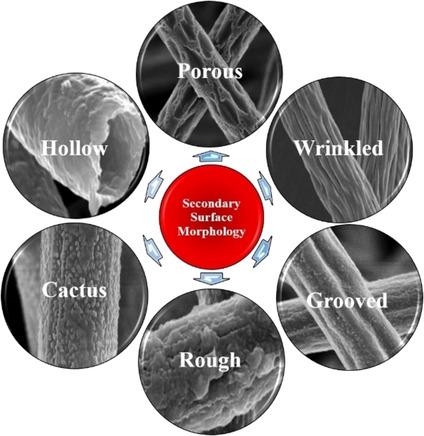当前位置:
X-MOL 学术
›
ChemistrySelect
›
论文详情
Our official English website, www.x-mol.net, welcomes your feedback! (Note: you will need to create a separate account there.)
A Review on the Secondary Surface Morphology of Electrospun Nanofibers: Formation Mechanisms, Characterizations, and Applications
ChemistrySelect ( IF 2.1 ) Pub Date : 2020-01-24 , DOI: 10.1002/slct.201903981 Bilal Zaarour 1, 2 , Lei Zhu 1 , Xiangyu Jin 1
ChemistrySelect ( IF 2.1 ) Pub Date : 2020-01-24 , DOI: 10.1002/slct.201903981 Bilal Zaarour 1, 2 , Lei Zhu 1 , Xiangyu Jin 1
Affiliation

|
Engineering the secondary surface morphology of fibers (fibers without smooth surface and solid interior) has been attracting significant awareness in various areas and applications. Among different methods of forming nanofibers, electrospinning is the most widely adopted technique due to the ease of forming fibers with a broad range of properties and its unique advantages such as the flexibility to spin into a variety of shapes and sizes as well as adjustable porosity of electrospun structures. In this review paper, more emphasis is put on the secondary surface morphology. A comprehensive overview of the basic principles about the electrospinning process, types of electrospinning, materials, formation mechanisms, characterizations, and applications of electrospun fibers with the secondary surface morphology (e. g. the porous structure, grooved structure, wrinkled structure, rough structure, cactus structure, and hollow structure) are discussed in detail. Importantly, we believe our work can serve as guidelines for the preparations, characterizations, and applications of electrospun fibers with the secondary surface morphology.
中文翻译:

电纺纳米纤维的次级表面形态学综述:形成机理,表征和应用
对纤维(没有光滑表面和坚固内部的纤维)的次级表面形态进行工程设计已在各个领域和应用中引起了广泛的关注。在各种形成纳米纤维的方法中,静电纺丝是最广泛采用的技术,因为它易于形成具有广泛性能的纤维,并且具有独特的优势,例如能够灵活地纺成各种形状和尺寸以及可调节的孔隙率。电纺结构。在这篇综述文章中,更多的重点放在次级表面形态上。有关静电纺丝工艺的基本原理,静电纺丝的类型,材料,形成机理,表征以及具有次级表面形态(例如多孔结构,凹槽结构,皱纹结构,粗糙结构,仙人掌结构和空心结构)进行了详细讨论。重要的是,我们认为我们的工作可以作为具有次级表面形态的电纺纤维的制备,表征和应用的指南。
更新日期:2020-01-24
中文翻译:

电纺纳米纤维的次级表面形态学综述:形成机理,表征和应用
对纤维(没有光滑表面和坚固内部的纤维)的次级表面形态进行工程设计已在各个领域和应用中引起了广泛的关注。在各种形成纳米纤维的方法中,静电纺丝是最广泛采用的技术,因为它易于形成具有广泛性能的纤维,并且具有独特的优势,例如能够灵活地纺成各种形状和尺寸以及可调节的孔隙率。电纺结构。在这篇综述文章中,更多的重点放在次级表面形态上。有关静电纺丝工艺的基本原理,静电纺丝的类型,材料,形成机理,表征以及具有次级表面形态(例如多孔结构,凹槽结构,皱纹结构,粗糙结构,仙人掌结构和空心结构)进行了详细讨论。重要的是,我们认为我们的工作可以作为具有次级表面形态的电纺纤维的制备,表征和应用的指南。



























 京公网安备 11010802027423号
京公网安备 11010802027423号